Have you ever looked at your pencil and noticed the tiny numbers and letters, wondering why they are there and what they mean? We're here to explain what they are so you'll understand them by the end of this article! We'll go over the different pencil grades that every artist needs to know to help you choose the right one for your needs.
How are Pencils Graded?
Pencil grades indicate the hardness or softness of the pencil's graphite core, which affects the darkness and precision of the marks it makes. These grades are part of a standardised system used to classify pencils based on the ratio of graphite to clay in the core. The two main grading scales are the HB scale and the numerical scale.
The HB Scale
The HB grading system is a standardised way to categorise pencils based on the hardness or softness of their graphite core, which affects the darkness and thickness of the marks they make. The HB system uses a combination of letters and numbers to indicate these properties.
H (Hard)Pencils with more clay and less graphite, producing lighter and finer lines. The range extends from H (hard) to 9H (hardest). |
|
|
|
B (Black)Pencils with more graphite and less clay, resulting in darker and softer lines. The range goes from B (soft) to 9B (softest). |
HBA middle-ground pencil that balances hardness and darkness, commonly used for general writing and drawing. |
|
|
|
F (Fine Point)Can be sharpened to a fine point, positioned between HB and H. |
What makes a pencil harder or softer?
The hardness or softness of a pencil is determined by the ratio of graphite to clay in the pencil's core. Here's how it works:
Composition of Pencil Core:
Graphite:A soft, black carbon material that provides the dark mark on the paper.Clay:A binder that holds the graphite together and adds structure.
|
|
|
|
Harder Pencils
Higher Clay Content:Harder pencils contain more clay and less graphite. The increased clay content makes the core more rigid.Characteristics:Hard pencils produce lighter and finer lines, are less prone to smudging, and maintain a sharp point longer. They are labeled with H (e.g., H, 2H, 3H) and are commonly used for technical drawing and fine details.
|
Softer Pencils
Higher Graphite Content:Softer pencils contain more graphite and less clay. The increased graphite content makes the core softer and more brittle.Characteristics:Soft pencils produce darker and thicker lines, are more prone to smudging, and wear down faster, requiring more frequent sharpening. They are labelled with B (e.g., B, 2B, 3B) and are preferred for sketching, shading, and expressive drawing.
|
|
|
|
Balance (HB Pencils)
Equal Balance:HB pencils have a balanced ratio of graphite to clay, making them versatile for general use.Characteristics:They provide a medium darkness and hardness, making them suitable for everyday writing and general-purpose drawing.
|
Which one do I use?
It really depends on what you plan on doing with your pencil. Here’s a quick guide to help you choose the right pencil for your needs:
General Writing
HB pencils are the most used for everyday writing tasks due to their balanced hardness and darkness.
Sketching
Artists often use a range of B pencils (2B to 6B) for sketching, shading, and creating darker lines.
Technical Drawing
Drafts men and architects prefer H pencils (2H to 6H) for precise, fine lines that are lighter and easier to erase.
Understanding these grades will help artists and writers select the right pencil for their specific needs, whether it's for shading, fine lines, or general writing.
If you're looking for drawing supplies, Eckersley's has a wide range of materials you need. From pencils and coloured pencils to graphite and everything in between, we've got you covered. Check out our selection of art supplies for every project you undertake.




















